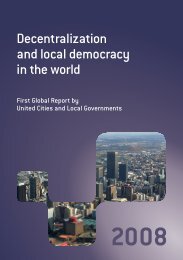Making Cities Resilient Report 2012
Making Cities Resilient Report 2012
Making Cities Resilient Report 2012
You also want an ePaper? Increase the reach of your titles
YUMPU automatically turns print PDFs into web optimized ePapers that Google loves.
ANNEXES<br />
Annex 1b.<br />
Methodology of the study<br />
This report is based on documentation provided by the urban centres involved in the Campaign. These documents<br />
include presentations made at Campaign meetings between 2010 and <strong>2012</strong> and reports from local governments reporting<br />
on the results of application of the HFA Local Governments Self-Assessment Tool. This report has also drawn information<br />
from documents prepared by NGOs and researchers, including documentation prepared by local governments that<br />
have applied for the UN-Sasakawa Award for Disaster Reduction. The IIED team preparing this report also conducted<br />
eleven personal in-depth interviews with Campaign city representatives and received ten written questionnaires (see<br />
interview questions in Annex 1c). In total, more than 90 sources and documents have been analysed from 42 cities. The<br />
UNISDR team collected additional feedback and information from cities and partners for the report. UNISDR transferred<br />
all reports and documentation received by cities to IIED and the authors during the kick-off workshop to define the scope<br />
of this report, held in Geneva, May <strong>2012</strong>. Where no definite date of the original issuance of a document is noted in the List<br />
of Reference, May <strong>2012</strong> has been used.<br />
The activities documented throughout the report are, by and large, self-reported by the cities. In this regard, the report<br />
provides a considerable level of detail as to the breadth of activities, although it cannot assess their impact. In analysing<br />
the documents, activities have been categorised and grouped for the most part according to the Ten Essentials checklist.<br />
Chapter 5 of the report considers how cities and smaller urban centres can identify and measure different aspects<br />
of resilience, what types of indicators can be used and the process for measurement. It draws on a range of current<br />
literature about measuring resilience, as well as literature on urban governance. It also draws on responses from the<br />
interviews on what they interviewees considered have been the main milestones for achieving resilience in their cities.<br />
Annex 1C.<br />
Questionnaire for Mayors and City Officials<br />
Background<br />
• What city do you represent<br />
• What is your department and position<br />
Resilience-building activities<br />
• Why did you join the campaign<br />
• Please provide details about specific initiatives/activities/programmes that your city has undertaken to to<br />
reduce the impact of hazards or disasters. For each activity, please provide the following information:<br />
a. Details about the name (where relevant), aims, nature and location of the project<br />
b. Source(s) of financial support for the project<br />
c. Whether the project has been associated with any organisational changes e.g. changes in legislation,<br />
disaster risk reduction guidelines or budgets<br />
d. Who has taken the lead for this project<br />
e. Which other stakeholders have been involved in the project (including different government departments,<br />
agencies, NGOs, private sector partners, community groups, etc.)<br />
f. Whether any similar projects are planned for the future (and brief details of these)<br />
g. Where we can find further sources of information or documentation about this<br />
<strong>Making</strong> <strong>Cities</strong> <strong>Resilient</strong> <strong>Report</strong> <strong>2012</strong> | 89

















